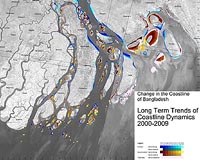 |
Cape Canaveral FL (SPX) Dec 21, 2009 The latest Geostationary Operational Environmental Satellite, GOES, developed by NASA for the National Oceanic and Atmospheric Administration (NOAA), called GOES-P, arrived on Thursday, December 17 on a C-17 military cargo aircraft at the Kennedy Space Center's Shuttle Landing Facility from its manufacturing plant in El Segundo, Calif. The GOES-P satellite is targeted to launch on February 25 onboard a United Launch Alliance Delta IV expendable launch vehicle. Once in geosynchronous orbit, GOES-P will be designated GOES-15 and NASA will provide on-orbit checkout and then transfer operational responsibility to NOAA. GOES-P will be placed in on-orbit storage as a replacement for an older GOES satellite. After arriving, the satellite was transported to Astrotech in Titusville, Fla., where final testing of the imaging system, instrumentation, communications and power systems will be performed. These tests will take approximately six weeks to complete. Then the spacecraft will be fueled with the propellant necessary for orbit maneuvers and the attitude control system. When the fueling is completed, the spacecraft is encapsulated in the Delta IV nose fairing and prepared for transport to the launch pad. GOES-P is the third and last spacecraft to be launched in the GOES N-P series of geostationary environmental weather satellites. The GOES satellites continuously provide observations of 60 percent of the Earth including the continental United States, providing weather monitoring and forecast operations as well as a continuous and reliable stream of environmental information and severe weather warnings. GOES-P carries an advanced attitude control system using star trackers and Hemispherical Inertial Reference Units. The imager and sounder instruments are mounted on a stable optical bench, which provides enhanced instrument pointing performance for improved image navigation and registration. This means better location of severe storms and other events important to the NOAA National Weather Service. The Imager on GOES-P, as on the GOES-O before it, has improved resolution from previous GOES missions in the 13 micron channel from 8 km to 4 km. The finer spatial resolution allows improved estimates of horizontal distribution of cloud-top, height of atmospheric motion vectors, and volcanic ash detection. Similarly to the GOES-O mission, the GOES-P image navigation accuracy of about 2 km from an orbit altitude of about 22,300 miles, or 35,700 km, is superior compared to the previous series of GOES satellites. GOES-P only differs from GOES-O in the channel configuration for the solar Extreme Ultraviolet (EUV) telescope. The EUV will be the same 5 channel configuration that flew on GOES-N/13. The multi-mission GOES N-P Series of satellites are vital contributors to weather, solar, and space operations and future science improvements with weather prediction and remote sensing. These satellites aid in severe storm warnings, resource management, search and rescue, emergency managers, and likely lead to additional advances in environmental sciences and multifaceted data applications of remotely sensed phenomena. GOES-P data will add to the global climate change databases of knowledge, embracing many civil and government environmental forecasting organizations that work to benefit people everywhere and help save lives. A United Launch Alliance Delta IV expendable launch vehicle will be erected in early January at Space Launch Complex 37-B, Cape Canaveral Air Force Station, Fla. NOAA manages the operational environmental satellite program and establishes requirements, provides all funding and distributes operational environmental satellite data for the United States. NASA's Goddard Space Flight Center in Greenbelt, Md., procures and manages the development and launch of the satellites for NOAA on a cost reimbursable basis. United Launch Alliance will conduct the commercial launch with a Federal Aviation Administration launch license. They will also oversee launch service duties that include oversight of the launch vehicle processing activities, integration of the GOES-P spacecraft with the Delta IV rocket and the launch countdown activities. Share This Article With Planet Earth
Related Links GOES-P and the geostationary satellites Earth Observation News - Suppiliers, Technology and Application
 ESA And World Bank Move Towards Closer Collaboration
ESA And World Bank Move Towards Closer CollaborationParis, France (ESA) Dec 16, 2009 The World Bank is a vital source of financial and technical assistance to developing countries around the world. At first glance, this may not appear to be connected to space technology, but large development projects and the state of Earth's environment are intrinsically linked. Global climate change is also an increasingly important challenge in overcoming poverty and advancing ... read more |
|
| The content herein, unless otherwise known to be public domain, are Copyright 1995-2009 - SpaceDaily. AFP and UPI Wire Stories are copyright Agence France-Presse and United Press International. ESA Portal Reports are copyright European Space Agency. All NASA sourced material is public domain. Additional copyrights may apply in whole or part to other bona fide parties. Advertising does not imply endorsement,agreement or approval of any opinions, statements or information provided by SpaceDaily on any Web page published or hosted by SpaceDaily. Privacy Statement |